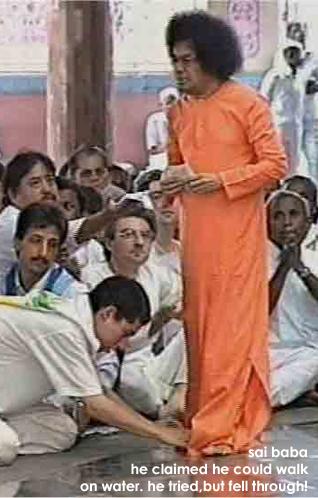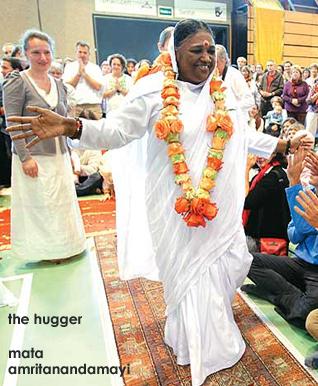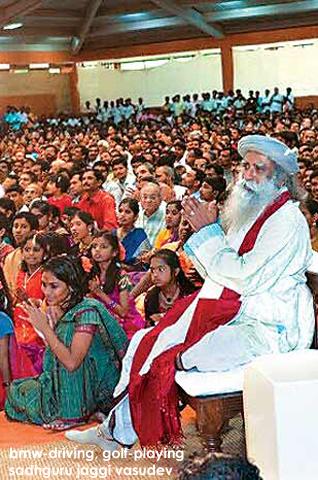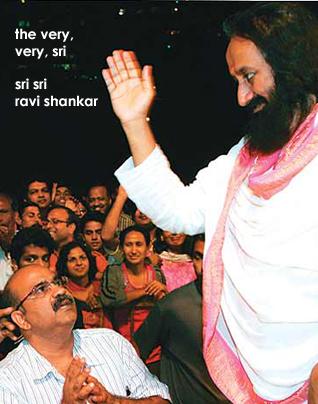Current Events
India's New Age Charlatans
by SHEELA REDDY
It was the last 'miracle' by the man who flew in the face of reason and defied the sceptics for seven decades. As 85-year-old Sri Sathya Sai Baba's emaciated body was lowered into his grave in a spectacle worthy of a rock star on Wednesday, April 27, 2011, hundreds of thousands of his devotees - including politicians, judges, bureaucrats, military officials, sports stars, scientists, professionals - stood patiently in line for a last glimpse of the man they believed was God.
Their faith in his divinity had withstood everything - from charges of homosexuality, a cover-up of murders in the ashram, exposes of his magic tricks, not to speak of the fabulous wealth controlled by his trust.
He was, as Katharina Kakar puts it, "India's Godman of the Twentieth Century."
An anthropologist who taught comparative religion in Germany before she married Indian psychoanalyst Sudhir Kakar and settled down in Goa, Katharina is one of a long series of scholars who were so fascinated with this "godman"'s charisma that she visited his ashram in Puttaparthi for a closer look. This was in 1995, when, according to her, Sai Baba was already "past his peak", but his aura was unmistakable. And indescribable:
"He knew how to play with the psychology of the devotees - the way he made the crowd wait in suspense, and then made a grand entrance, collecting from the frantic devotees the letters of prayers addressed to him." Then suddenly he would stop and talk to someone, looking deep into their eyes, creating a certain mesmerising moment. "You can't train or learn this-either you have it or you don't," she explains. And Sai Baba certainly had it: the quality of a rock star.
By the 1990s, according to Katharina, he had so assiduously cultivated high-profile devotees as well as tapped into a rising middle class's yearning for a short-cut to spirituality that his organisation had grown into a vast spiritual empire, with centres in over 130 countries. He had turned from a mere miracle-performing 'godman' into a carefully managed spectacle. His birthdays, for example, were celebrated in a large stadium built in the ashram which could accommodate over 50,000 devotees, and became big shows designed to strike awe and reverence: "big miracles, music, spectacle."
Khushwant Singh, a well-known godman-buster throughout his long journalistic career, knows only too well how adept the godman was at cultivating high-profile devotees. There was his friend, the late jurist famed for his sharp mind and scepticism, Nani Palkhivala. In the last two years of his life, Palkhivala kept a portrait of Sai Baba on his desk. When Khushwant grilled him about it, the jurist who struck fear in the court refused to respond.
It was a pattern Khushwant began noticing among the dozens of his friends and acquaintances who eventually succumbed to Sai Baba's spell. "It was like a crutch. If you tried to talk to them about it, they got angry."
Khushwant was baffled: why did otherwise sensible and modern men and women turn into devotees of 'godmen' like Sai Baba? He eventually got a chance to find out. He received a letter from Sai Baba's manager, asking him if he would like a private meeting with the 'godman'.
"Yes," he replied promptly. But when it came closer to the appointed day, another letter arrived, saying brusquely: "Sai Baba feels you are not yet ready to receive him."
It's this ingenious blend of active pursuit and playing hard to get that probably won Sai Baba his impressively long list of high-profile devotees, ranging from presidents, prime ministers and central ministers to top bureaucrats, scientists and other professionals.
They undoubtedly came in useful when Sai Baba was battling the charges against him by several former bhakts, feels Katharina. "These were serious charges, some of them probably with a grain of truth. But he had good contacts and there was possibly a cover-up," she explains. "And the charges never stuck, because the devotees didn't want to believe them and glossed over them."
Like Dr Prabhakar Korada, a psychiatrist and professor in Mediciti Institute of Medical Sciences in Hyderabad. Dr Korada, who started off like the bulk of Sai Baba's professional and modern-day devotees as a sceptic, dismisses the various charges against Sai Baba as "organised anti-propaganda". The journey of the psychiatrist from sceptic to believer is typical of the miracle that Sai Baba performed on countless souls over the coming decades: the doctor was going through a severe emotional and professional crisis in his life, when Sai Baba appeared in his dreams. "Even in my dream, I questioned him about his magic," recounts the doctor. Sai Baba responded by placing a foot on his chest, "as if to feel my heartbeat".
After a couple of years of these recurrent dreams, Dr Korada landed up in Puttaparthi. He became impressed with the 'godman' and the social work he was doing in and around the village. There was a mysterious transformation and Korada's life suddenly improved for the better. Now his family keeps a picture of Sai Baba in the puja room and worships the 'godman'.
This is why Sai Baba was so successful, believes Katharina - he was not only the pioneer of the 'godman'-as-social worker prototype - the first one to build schools, colleges, hospitals, orphanages, even a public water works. But, better, he was able to persuade hundreds of thousands of people that he was close to their hearts even when he was miles away - that he could manifest himself in their dreams. "A sort of God at the end of a telephone line, who can solve all your problems, worldly and emotional."
He wasn't like the meditative, reclusive godmen before him, like Ramana Maharishi, who withdrew from people. "Sai Baba needed the crowds to believe he was god, just as much as the crowds needed him to be god, so that they could convince themselves that anything was possible."
The only other 'godman' who came close to him in popularity was perhaps Osho Rajneesh. "But Rajneesh was someone who loved to shock. He was too provocative, too sexual to appeal to the Indian middle class," feels Katharina.
Like Rajneesh, the 'godmen' who came before Sai Baba were mostly the export-quality type - catering to the spiritual needs of an increasingly alienated, rebellious post-war generation looking for alternative routes to spirituality. Sai Baba, on the other hand, was an indigenous creation who had somehow touched the nerve of a new India and continued to keep his finger on the religious pulse.
By the 1990s, as philosophy and religion scholar Meera Nanda writes in her seminal work, The God Market, a rising and affluent middle class's craving for an alternative spirituality more in sync with their new lifestyle had resulted in a highly competitive 'godman' market, each fishing for followers in the same pool: upwardly mobile Indians, Indians living outside India, and "Western seekers" - "the Indian middle classes who have acquired the lifestyle of their Western counterparts and who share their taste in new age-ish spirituality".
Having arrived on the scene before the deluge of 'godmen', Sai Baba naturally had an edge over his competitors. But Nanda lists three kinds of 'godmen' who came in his trail: the "miracle-makers" who follow Sai Baba's style of producing objects from thin air; the Veda-expounding type; and the meditation/ yoga/ alternative medicine variety.
To Nanda, Mata Amritanandamayi or Amma, as her millions of devotees call her, is a good example of the reason-defying miracle-worker type of guru. Devotees may flock to her for her trademark kiss and embrace, but it's the miracles that cement their faith - the appearances in dreams, the belief that they owe all their breaks, big and small, to her. Like Sai Baba's flock, Amma's devotees too begin by being sceptical non-believers who are nevertheless in search of someone who will fill their spiritual void.
Like Sai Baba's organisation, Amma's is a vast, multinational corporation, managed with an impressive hierarchy of volunteers - including "mantra monitors" and "post-mantra instructors" - and spectacular ritual ceremonies conducted on a raised stage, complete with TV cameras on cranes.
The second type of 'godman', appealing mostly to the business and professional class who want more philosophy and less magic, is usually a pious and learned man, "well-versed in the scriptures, yet at ease in the modern boardroom," says Nanda. The sort who turns the Bhagvad Gita into a modern plan for living and equates this-worldly success with spirituality.
But it is the meditation/ yoga type of 'godman' that has really taken the country by storm. Like Sri Sri Ravi Shankar, whose Art of Living - a mish-mash of breathing exercises and "rock satsangs" where hundreds congregate after work to sing and dance to devotional songs - is fused with a fuzzy are-you-happy type of spirituality.
"This type of 'godman' is meeting a need in modern-day society," concedes Jyotirmoy Sharma, another scholar who's looked closely at the rising trend in 'godmen', pointing out that the majority of Ravi Shankar's devotees work in the IT industry. "When you have to sit 12 hours in front of a machine, you need something to anchor you. It's a form of therapy."
Earlier, Sharma says, you had gurus who showed you the path to enlightenment. "Now you have godmen who say don't bother your head about the larger questions, just trust in me, and everything will be okay."
Is it an Indian thing then, this infantile craving for a 'godman' or 'godwoman' to shoulder our cosmic burden, to whom we so readily surrender our modern, scientific selves like hapless children, touchingly dependent on his or her approval for every move we make in our life?
There's, of course, the long Hindu tradition we have imbibed, where the line between gods and men has always been blurred, which one could argue gives us an inherited susceptibility to 'godmen'.
Or there are scholars like Peter Brent, who argues in his Godmen of India: "In the West, we are free to work for the approval of those we love and respect. But for Indians, particularly those of the middle classes, there are only two directions they can go to prove that they can love and be loved. One is towards homosexuality, the other towards the 'godmen' - the two not being mutually exclusive." Really!
Nanda's argument seems more convincing. 'Godmen' are proliferating because there has been no strong counter-movement against it. Leaders like Nehru, Ambedkar and M.N. Roy did try to infuse what they called "a scientific temperament", but there was really no strong movement to support their well-intentioned move, according to Nanda. Even the rationalists never moved beyond exposing the "godmen"'s "miracles".
Then there's our educational system: their plan for secularising Indians was to ignore the spiritual needs of the new generation. In contrast, the mainstream Christian churches in the West shed most of their dogmas and rituals in order to meet the religious needs of a modernised, industrialised community. Nanda, who studied in India, getting a doctorate from IIT before settling in the US, should know what she's talking about: "We were dealing with mind-boggling ideas like molecular biology, but with no relation to our own culture and consciousness." No wonder, she says, you now have a generation of the scientifically trained who speak in a strange language of "pseudo-scientism" - seeking to validate the avatars of Vishnu as a precursor of Darwin, or astrophysicists who do pujas during an eclipse.
Nanda comes up with another reason why the affluent middle classes worship their 'godmen': they rid us of our guilt complex! Indians have always been schizophrenic about wealth - while they love to make money, they admire men or women who have renounced wealth.
"Godmen," Nanda says, "take away the edge of guilt about being rich by teaching the newly affluent how to balance material prosperity with spiritual pursuits."
But the deluge of 'godmen' these days could be a dangerous trend. Despite their claims of being eclectic, most 'godmen' and 'godwomen' lean dangerously towards the Hindu right, dropping their secular credentials at crucial times like during the Ayodhya dispute. Sai Baba, incidentally, was the only leading godman who refused to buckle under pressure from the Vishwa Hindu Parishad to issue a statement favouring the construction of a Ram temple in Ayodhya. But if the Hindu rituals and chants at his funeral are a foreboding of the future, it won't be long before he too is roped in as the Great Hindu Hope of the New Century.
[Courtesy: Outlook]
May 4, 2011
Conversation about this article
1: Brijinder Singh (New York, U.S.A.), May 04, 2011, 12:50 PM.
I can't believe these crooks and perverts are worshipped like gods. That afro baba looks like a 70's disco dancer.
2: Devinder Singh (India), May 04, 2011, 1:05 PM.
I knew one such baba. I first walked into Ramesh Balsekar's upscale apartment off Warden Road in Mumbai one April morning a decade ago, having read about him in a new-age magazine. Balsekar styled himself an "enlightenment teacher"; peddling a commodity he did not have. In banking parlance, this is called short selling. He was a former general manager at Bank of India. His teaching emphasized that human beings play out a pre-scripted act on the world stage, with no scope for play of free will or change of possible outcome. The divine play is a fixed match, is what one understood from him. And if my script said I could not believe him, he hoped to convince me yet. He asked me to come again. It is for good reason that our Gurus have cautioned against false babas. We who live in ignorance are not knowledgeable and cannot tell the true from the false. Ordinary humanity, in a general way, not being in personal contact with the divine powers, understands nothing of what an illumined consciousness may be. It is not at all necessary to have a divine power or consciousness to perform miracles. This can be done with the help of small entities of the vital world. Miracles only prove only one thing, that these 'masters' are in contact with the powers of the vital world and that with the help of those beings they can perform these miracles.
3: Bibek Singh (Jersey City, U.S.A.), May 04, 2011, 1:42 PM.
It is a sad reality that people like Bhagat Puran Singh ji, who dedicated his entire life serving the destitute, had to wait for 10 long years to get permission to build a small hospital. On the other hand, we commonly see acres of land being donated to such 'godmen' for 'noble causes'. Sri Sathya Sai baba himself received many such donations during his lifetime. He could therefore initiate the construction of many hospitals, colleges, etc. and establish his image among the common masses. This is what differentiated Sri Sathya Sai Baba from Shirdi's Sai Baba. To those readers who are not aware, Sathya Sai Baba used to claim himself as an incarnation of Shirdi's Sai Baba.
4: Gobinder Singh (U.S.A.), May 04, 2011, 6:59 PM.
Babas, sants and Sri Sri 108 xyz are dime a dozen in India. Sadly, Punjab is not too far behind. There are more self-styled sants in Punjab than the number of villages. Why do they keep mushrooming across the country and why do people who seem very intelligent otherwise, keep falling into their snares? One of my co-workers, a South Indian - intelligent guy - was follower of some young lad called Swami Nityananada until a TV channel exposed him by showing a racy video clip of the swami with a B-grade South Indian actress! I am sure he will soon find somebody else to follow, if he hasn't already done so.
5: Sangat Singh (Kuala Lumpur, Malaysia), May 04, 2011, 8:34 PM.
An inmate of the famous Tihar Jail was ready to graduate after serving his term. He declared that he was going to make at least Rs. 500,000.00 by selling a hundred thousand tabeets (talismans) at Rs. 5/- a piece. "Who will buy them?" asked his fellow inmate. "What, with a population of over a billion plus, won't there be at least a hundred thousand fools among them!" Open any TV network and you will find at least one channel exclusively devoted to selling specially made holy 'rudraksh malas' - talismans. Ganesh/ Lakshmi statues and other artifacts - to bring you untold wealth, to solve all your worldly cares. Of course, such an invaluable artifact had to be sold. Nothing ventured, nothing gained. But, looks like this does not work for the promoters themselves despite these miracle aids at their disposal. You still need fools to buy them and there is no dearth of them. Spiritual super markets abound everywhere and vigorously promoted on the Internet and ubiquitous blogs providing a quick fix for all that ails you. There is even a museum of World Religions opened in 2001 as a brainchild of a Buddhist monk where you have a wide choice available. If you are such a hopeless case, there is even a section devoted to an after-life trip tailored for today's tech-savvy generation. The other day a visiting raagi jathaa mentioned to me that Malaysia was not a good market for them. They were aiming to go to the U.S.A., Canada or U.K. where the offerings were in dollars and pounds as against the lowly Malaysian Ringgit!
6: Mohan Singh (Toronto, Ontario, Canada), May 04, 2011, 10:53 PM.
Guru Gobind Singh said: "jin jin tanik saadh kamayo tinhi apna naam japayo".
7: Raj (Canada), May 04, 2011, 11:04 PM.
I have long grey hair, not to mention my athletic and not-so flexible body. I have been told that I'm 10477154th re-incarnation of Shiva. I think I have all the credentials to become a successful baba. Any volunteers to help me? We'll be leer-jet flying type elite ones. Please contact me asap.
8: Sunny (London, United Kingdom), May 05, 2011, 9:05 AM.
To quote Albert Einstein ... "Two things are infinite, the universe and human stupidity, and I'm not sure about the universe."
9: Brijinder Khurana (Delhi, India), May 06, 2011, 2:00 AM.
Let people do what they want. Let us not waste time in criticizing others because until the believers of these "godmen" will not taste the bitterness, they will continue believing them. We should rather praise the goodness of our own Gurus, spread the teachings given in our Guru Granth Sahib. We should teach our children and society about Bhagat Puran Singh. After that, if time permits, we should raise questions with the leaders of our panth, as to what they are doing for Sikhism. Are they just politicizing our gurdwara or helping the poor and the needy. Recently, in Delhi, Sant Kar Seva Wale - Bhai Harbans Singh ji - left us. During his last rites, the senior leaders of our Sikh panth were not present, nor were any orders passed by them to all the gurdwaras for some special arrangements. Just small posters were hanging on the road courtesy a few devotees of Bhai Sahib. But yes, for the kriya ceremony, all the so-called leaders were present in an air-conditioned gurdwara hall to give lectures, and to fool the ordinary public. They don't understand that the public understands that in these hot summer days, why these politicians of the gurdwara parbandhak committee will not go for the cremation of one who has served mankind all these years. This system is required to be cleansed.
10: Dosanjh (London, United Kingdom), May 07, 2011, 9:42 AM.
I was beginning to think that all these people following these strange 'holy men' must be incredibly naive, but then I just remembered ... most of the people around me follow a carpenter who also, reportedly, performed a magic trick with a fish.






